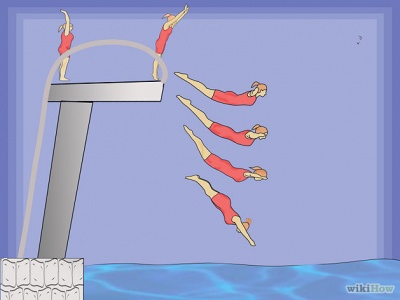AY Honors/Springboard Diving/Answer Key
Template:Honor desc Template:Honor Master
1. Demonstrate the following dives: a.Swan b. Front somersault (tuck) c.Half twist
While not an explicitly stated requirement, you will need an experienced diving instructor to judge correct form in your dives. Learning swimming and diving skills is best done with an instructor. We provide guidance as follows:
a. Swan
- Distance yourself. One step should do it. You need enough room to build up enough momentum, but if you run then you will probably slip.
- Check the depth of the pool. Only swan-dive in the deepest end reachable, as the swan-dive will take you very deep very quickly.
- Put your strongest leg forward. Your toes should be just hanging over the edge of the pool. Your other leg can be next to it or several inches behind, it depends on your preferences.
- Spread your arms to your side. This is essential for later.
- Push off from the side of the pool. Be sure to push slightly up, too. Snap your legs together tightly and lean forward when you do. Your body should be slightly bent.
- Force your arms forward so your body is in a pencil-like shape. Do this quickly, as time is tight.
- Angle your body at a 45+ degree angle to the water. If possible, do this as you push off from the edge.
- As you enter the water, lean your head forward and lift your legs up. You should enter the water smoothly with little splashing.
- Practice. This is essential, as nobody can perfectly execute a swan-dive first-time.
b. Front somersault (tuck)
- First, take a few steps forward and jump.
- Bounce at the end of the board.
- Throw your arms forward and tuck your head to your chest.
- During the somersault, tuck your arms and legs to your chest.
- You have to land the rotation on your feet or it could lead to a belly flop or a back flop.
https://www.youtube.com/watch?v=UrChg4d9bnw
c. Half twist
https://www.youtube.com/watch?v=yNTlhag-9XA
2. Chose two optional dives from the following: half gainer (tuck, pike, or lay-out), cutaway, somersault front one and one-half, sailor dive, half twist, back dive, back knife, back jack.
a. Half twist
https://www.youtube.com/watch?v=tZpUieK9UdI
b. Cutaway
c. Somersault front one and one-half
https://www.youtube.com/watch?v=bCYa9Fzrb2U
d. Back dive
https://www.youtube.com/watch?v=aLSyi4FRURw
e. Back jackknife
f. Half gainer (tuck, pike, or layout)
https://www.youtube.com/watch?v=svCWwoMmy1c
3. State the safety depths of water under a one-meter board, a three-meter board, and a tower. How far should the board project over the pool? What boards are recommended?
Springboards are usually located either 1.0 or 3.0 metres (3 ft 3 in or 9 ft 10 in) above the water surface. It is very seldom that one is mounted at a height other than these two standard heights.
| Board Height | Pool Depth | Projection (NCAA) & |
|---|---|---|
| One meter | 2.5 meters | 1.5 meters |
| Three meter | 5 meters | 1.5 meters |
| A tower | 8 meters | 1.5 meters |
Historically springboards were made of wood. Modern springboards (since about 1960) are made out of a single-piece extrusion of aircraft-grade aluminum. The Maxiflex Model B, the board used in all major competitive diving events, is made out of such aluminum, and is heat treated for a yield strength of 50,000 psi. The slip-resistant surface of the board is created using an epoxy resin, finished with a laminate of flint silica and alumina in between the top coats of resin. This thermal-cured resin is aqua-colored to match the water of a clean pool.
==In the test each candidate will announce the dive type and be judged accordingly.
Basis of Judging. Attention position for running dives: attention position on end or board for standing dives based on (a) approach, (b) spring, (c) way body is carried through the air, lay-out, tuck, or pike, (d) entry into water.==
These lines are not numbered but are part of the official requirements. You will need an experienced diving instructor to judge the dives.


